
Pasta Zara, Italy’s second pasta producer and its leading exporter said in a press release that revenues in 2015 rose 8.4% since the prior year, reaching 285 million euro. In particular, as data showed, during the year the Italian pasta maker sold a total of 264,387 tonnes of pasta. Moreover, in the first quarter of 2016 Pasta Zara said revenues rose 7% compared to the same period in the previous year, with volumes rising to 94,023 tonnes from 86,864 tonnes. What about their main plans? According to the statement, in the current year, Pasta Zara said it has continued to reinforce its presence in foreign markets. “As far as this aspect is concerned, the most interesting area is the Middle East, in particular Iran,” said company chairman Furio Bragagnolo.
THE IMPORTANCE OF THE ITALIAN F&B IN THE MIDDLE EAST – The Italian food companies are preparing themselves for a sustainable life in new Middle Eastern emerging markets. Currently, the Italian food industry accounts for more than 130 billion euro (from revenue in 2015) in the Middle East and for the next year is estimated at over 134 billion euro of which 29 billion euro will come from export sales. Indeed, according to ICE official data, they are about 22% of the food trade with 58,000 active companies and 385,000 employees. Bilateral ties are reflected in trade growth of more than 6 billion euro last year, and Italy is particularly the second largest European Trade partner to the UAE. It can be stressed that the UAE is the largest growing market for the Italian food industry and it remains a very attractive market thanks to the development of tourism and the prospects of EXPO 2020 for which many additional hotels will be built and consequently hundreds of new restaurants, including Italian. Consequently, Italian food companies are striving to offer a very wide range of high quality products from fresh fruits and vegetables, to dairy products, mainly a large variety of cheeses, pulses, dried and canned foods, dried and frozen foods, grocery products, olive oils and vinegar, and juices, not forgetting sweets and snacks.
